Three Vinegar Tasters Scroll Paintings and Posters
About Three Vinegar Tasters | ||||||||||||||
|
The Vinegar Tasters painting is the most popular painting related to taoism. It was
made even more famous when the book "Tao of Pooh" mentioned this piece of art.
The following is a summary of the passages from the book... Three men are standing around a vat of vinegar. Each one has dipped his finger into the vinegar and has tasted it. The expression on each man's face shows his individual reaction. Since the painting is allegorical, we are to understand that these are no ordinary vinegar tasters, but are instead representatives of the "Three Teachings" of China, and that the vinegar they are sampling represents the Essence of Life. The three masters are Confucius, Buddha, and Lao Zi, author of the oldest existing book of Taoism. The first has a sour look on his face, the second wears a bitter expression, but the third man is smiling. To Confucius, life seemed rather sour. He believed that the present was out step with the past, and that the government of man on earth was out of harmony with the Way of Heaven, the government of, the universe. Therefore, he emphasized reverence for the Ancestors, as well as for the ancient rituals and ceremonies in which the emperor, as the Son of Heaven, acted as intermediary between limitless heaven and limited earth. Under Confucianism, the use of precisely measured court music, prescribed steps, actions, and phrases all added up to an extremely complex system of rituals, each used for a particular purpose at a particular time. A saying was recorded about Confucius: "If the mat was not straight, the Master would not sit." This ought to give an indication of the extent to which things were carried out under Confucianism. To Buddha, the second figure in the painting, life on earth was bitter, filled with attachments and desires that led to suffering. The world was seen as a setter of traps, a generator of illusions, a revolving wheel of pain for all creatures. In order to find peace, the Buddhist considered it necessary to transcend "the world of dust" and reach Nirvana, literally a state of "no wind." Although the essentially optimistic attitude of the Chinese altered Buddhism considerably after it was brought in from its native India, the devout Buddhist often saw the way to Nirvana interrupted all the same by the bitter wind of everyday existence. To Lao Zi, the harmony that naturally existed between heaven and earth from the very beginning could be found by anyone at any time, but not by following the rules of the Confucianists. As he stated in his Tao Te Ching, the "Tao Virtue Book," earth was in essence a reflection of heaven, run by the same laws - not by the laws of men. These laws affected not only the spinning of distant planets, but the activities of the birds in the forest and the fish in the sea. According to Lao Zi, the more man interfered with the natural balance produced and governed by the universal laws, the further away the harmony retreated into the distance. The more forcing, the more trouble. Whether heavy or light, wet or dry, fast or slow, everything had its own nature already within it, which could not be violated without causing difficulties. When abstract and arbitrary rules were imposed from the outside, struggle was inevitable. Only then did life become sour. To Lao Zi, the world was not a setter of traps but a teacher of valuable lessons. Its lessons needed to be learned, just as its laws needed to be followed; then all would go well. Rather than turn away from "the world of dust," Lao Zi advised others to "join the dust of the world." What he saw operating behind everything in heaven and earth he called Tao (DAO), "the Way." A basic principle of Lao Zi's teaching was that this Way of the Universe could not be adequately described in words, and that it would be insulting both to its unlimited power and to the intelligent human mind to attempt to do so. Still, its nature could be understood, and those who cared the most about it, and the life from which it was inseparable, understood it best. Over the centuries Lao Zi's classic teachings were developed and divided into philosophical, monastic, and folk religious forms. All of these could be included under the general heading of Taoism. But the basic Taoism that we are concerned with here is simply a particular way of appreciating, learning from, and working with whatever happens in everyday life. From the Taoist point of view, the natural result of this harmonious way of living is happiness. You might say that happy serenity is the most noticeable characteristic of the Taoist personality, and a subtle sense of humor is apparent even in the most profound Taoist writings, such as the twenty-five-hundred-year-old Tao Te Ching. In the writings of Taoism's second major writer, Zhuang Zi, quiet laughter seems to bubble up like water from a fountain. In the painting, why is Lao Zi smiling? After all, that vinegar that represents life must certainly have an unpleasant taste, as the expressions on the faces of the other two men indicate. But, through working in harmony with life's circumstances, Taoist understanding changes what others may perceive as negative into something positive. From the Taoist point of view, sourness and bitterness come from the interfering and unappreciative mind. Life itself, when understood and utilized for what it is, is sweet. That is the message of The Vinegar Tasters. | ||||||||||||||
| ||||||||||||||
|
Here are the immortal people who have limited serialized paintings of the "Three Vinegar Tasters" (Golden Edition) by a master painter in China. | ||
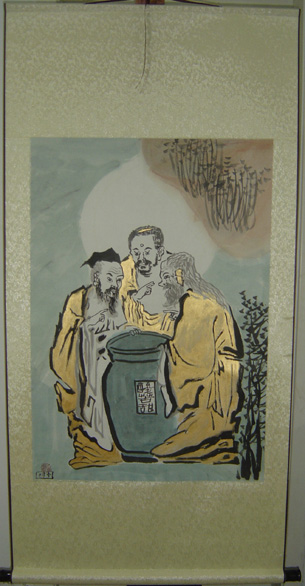
Three Vinegar Tasters - Serial #1David Peterson Evergreen Park, Illinois |
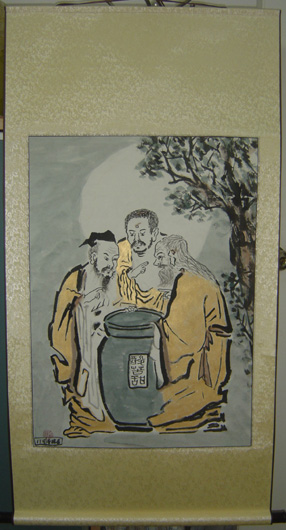
Three Vinegar Tasters Scroll (Golden)
|
|
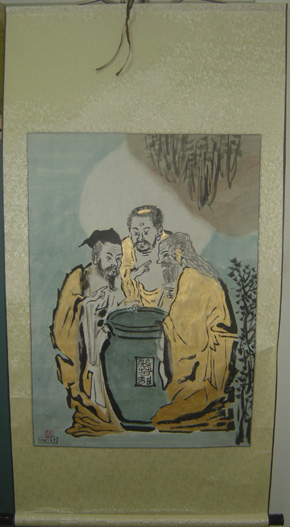
Three Vinegar Tasters - Serial #2Rena Wagner Berlin, Germany |
#3: David Carbo Saladrigas, Barcelona, Spain #4: Malcom Levi, Memphis, Tennessee #5: Virginia Matthews, Seattle, Washington #6: Jan MacIntyre, St. Joeseph, Michigan #7: C. Epperson, Tampa, Florida #8: S. Mindlin, Great Neck, New York #9: J. Randall, Lebanon, New Hampshire #10: J. Odling, Los Angeles, California #11: F. Fredriksson, Orsa, Sweden #12: D. Salko, Brunswick, Maine #13: J. Gunderson, Denver, Colorado #14: S. Ford, Columbus, Ohio #15: K. Hanka, Houston, Texas #16: D. Christensen, Queensland, Australia #17: C. Hoechstetter, Boulder, Colorada #18: J. Dalby, Leesburg, Virginia #19: B. Sheumaker, Garden Grove, California #20: J. Suydam, Syracuse, New York #21: B. Wolovich, Sewickley, Pennsylvania #22: R. Gordon, Windsor, Connecticut #23: J. Leonardis, South Plainfield, New Jersey #24: D. S. Turner, Prucellville, Virgina #25: N. McElrath, Fallon, Nevada #26: L. M. Cowden, Dallax, Texas #27: T. Rhodes, Alberta, Canada #28: R. Aquino, Keaau, Hawaii #29: B. B. Baker, San Angelo, Texas #30: N. Glemming, Colorado Springs, Colorado #31: K. Smith, Melbourne, Florida #32: P. H. Perry, Schenectady, New York #33: C. R. Reichmann, Bellevue, Nebraska #34: C. A. Burlingame, Verona, Wisconsin #35: L. Deater, Kittery Point, Maine #36: C. Lens, Zoetemmer Netherlands #37: H. Lavu, Bryn Mawr, Pennsylvania #38: S. Feldman, Cambridge, Massachusetts #39: D. Occoquan, Durham, North Carolina #40: G. Rowett, British Columbia, Canada #41: D. Christensen, Minneapolis, Minnesota #42: J. Ruth, Lehighton, Pennsylvania #43: U. Julien, Whitefish Bay, Wisconsin #44: S. Richards, Nashua, New Hampshire #45: S. Lewis, Kent, United Kingdom #46: D. Heise, Arcata, California #47: L. deBoisblanc, New Orleans, Louisiana #48: J. Lockard, Centreville, Virginia #49: D. Penza, Rochester, Minnesota |
|
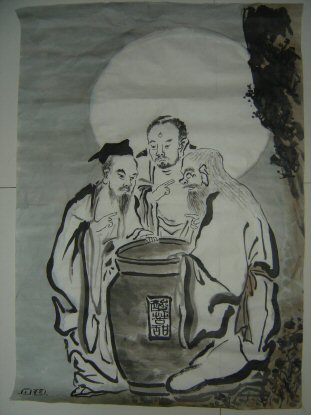
3 Vinegar Tasters - Serial #1Robert Schwartz, Jr Cinnaminson, New Jersey, USA |
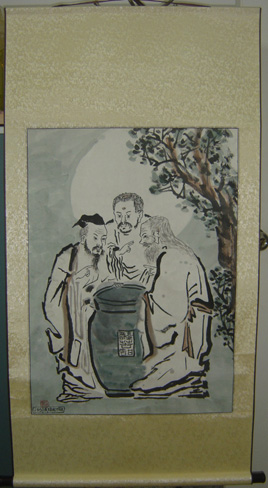
Three Vinegar Tasters Scroll (Classic)
|
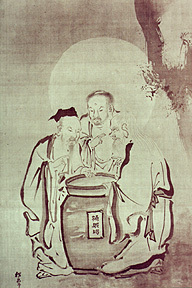
| ||||||||||||||||||||||||||||||||||||||||||||||||||||||||||||||||||||||||||||||||||||||||||||||||||||||||||||||||
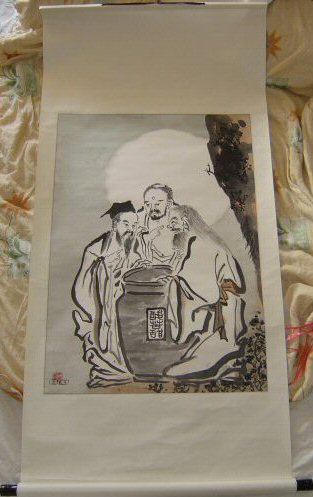
3 Vinegar Tasters - Serial #2Chris Joiner Kihei, Hawaii, USA 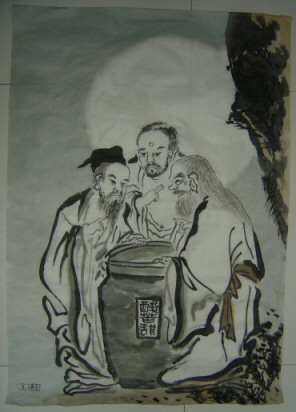
3 Vinegar Tasters - Serial #3David Heflin Clarksville, Tennessee, USA 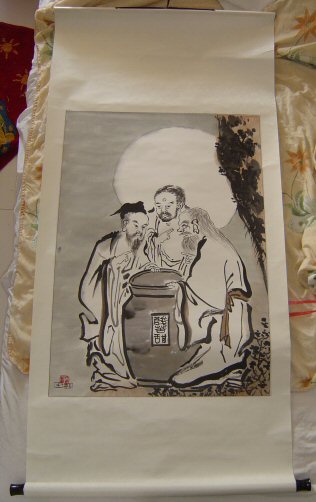
3 Vinegar Tasters - Serial #4Michael Rotman Pine Mountain Club, California, USA 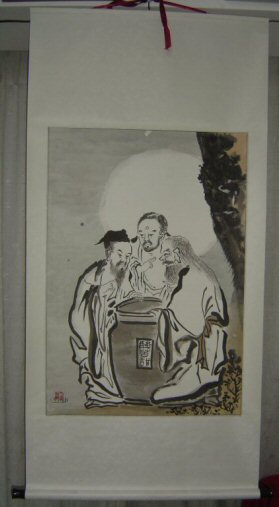
3 Vinegar Tasters - Serial #5Andrea Avila Burbank, California, USA |
The following are the first 100 owners of the classic limited edition serialized paintings of the "Three Vinegar Tasters" by a master painter in China. Purchase now to get your own serialized version of the Vinegar Tasters. To see more serial numbers of other
owners, visit Donors and more owners of Vinegar Tasters scroll painting.
#6: Jay Ronca, King of Prussia, Pennsylvania #7: Martin Ho, Denver, Colorado #8: Andy Quintilian, Baltimore, Maryland #9: Jennifer Welsh, Imperial, California #10: Brett D. Wheat-Simms, Chickasha, Oklahoma #11: Grant Higgins, Dearborn Heights, Michigan #12: W Stacy Huntington, Glendale, Arizona #13: Marisa Hart, Ann Arbor, Michigan #14: An Milliron, Augusta, Georgia #15: Michelle Lin, Cleveland, Ohio #16: Peter Poutiatine, San Anselmo, California #17: Steve Drum, Valrico, Florida #18: Lee Juvarkar, Miami, Florida #19: Steve Drum, Valrico, Florida #20: Robert A. Waller, Pasadena, California #21: Rachel Burr, Troy, Michigan #22: Lee Juvarkar, Miami, Florida #23: Dustin Williams, Moody, Alabama #24: Jill Heinrich, West Mifflin, Pennsylvania #25: Steve Drum, Valrico, Florida #26: Kristine Heinrich, Concord, North Carolina #27: Michele Tringali, Baltimore, Maryland #28: Lee Juvarkar, Miami, Florida #29: Kari Schmidt, Washington DC #30: Curt Cook, San Antonio, Texas #31: L. Challice, Banffshire, United Kingdom #32: A. Keto, Raleigh, North Carolina #33: M. Blume, Bad Vilbel, Germany #34: C. Miller, Port St. Lucie, Florida #35: R. Meyer, Kendall Park, New Jersey #36: J. Lertpatthanakul, Pembroke, Massachusetts #37: K. Cole, West Chester, Ohio #38: C. Joiner, Pitman, New Jersey #39: C. Thompson, Lafayette, Louisiana #40: J. Minick, Evansville, Indiana #41: S. Davis, College Station, Texas #42: R. Farshler, Austin, Texas #43: S. Romine, Kelseyville, California #44: R. White, Cleveland, Ohio #45: S. Feehan, Perry, Georgia #46: J. R Cottrill, Brunswick, Australia #47: P. Hitzelberger, Royal Oak, Michigan #48: E. Smith, Chantilly, Virginia #49: D. Malychansy, Milwaukee, Wisconson #50: S. Israels, British Columbia, Canada #51: J. Flyagina, New York, New York #52: S. O'Brien, Temecula, California #53: J. Clark, Kennesaw, Georgia #54: G. Tally, Wichita Falls, Texas #55: K. O'Connor, Loveland, Ohio #56: S. Patel, New York, New York #57: K. Rozelle, Irvine, California #58: N. Carter, Los Angeles, California #59: C. Magaro, Marysville, Pennsylvania #60: J. Towles, Reynoldsburg, Ohio #61: J. Flyagina, New York, New York #62: M. Lewin, Corpus Christi, Texas #63: A. Shah, Atlanta, Georgia #64: D. Fulton, Las Vegas, Nevada #65: J. Andersen, Glendale Heights, Illinois #66: J. Tribby, Palo Alto, California #67: D.Bidwell, Houston, Texas #68: L. Passue-llo, Clearwater, Florida #69: B. Fieser, Bradenton, Florida #70: J. Dabian, Chattanooga, Tennessee #71: L. Ghiselli, Denver, Colorado #72: R. S. Cockerham, Crowley, Louisiana #73: J. Caballero, Pembroke Pines, Florida #74: J. Pierangeli, Seattle, Washington #75: K. Millard, South Lanarkshire, United Kingdom #76: D. Floyd, Marietta, Georgia #77: P. Windsor, Burbank, California #78: A. Cavina, Clemmons, North Carolina #79: J. Kittle, Los Gatos, California #80: T. King, Decatur, Georgia #81: H. Riley, Newport News, Virginia #82: J. Morrissey, Charlottesville, Virginia #83: R. Fazel, Las Cruces, New Mexico #84: R. Hann, Canandaigua, New York #85: K. Spiegel, Washington DC #86: J. Janosky, Reading, Pennsylvania #87: C. Ortloff, North Mankato, Minnesota #88: J. Hein, Rex, Georgia #89: S. Flores, Midland, Texas #90: R. Bagley, Santa Monica, California #91: Y. Kuo, San Francisco, California #92: M. Isberg, San Diego, California #93: C. Lueders, Bonn, Germany #94: M. Bruce, Westerville, Ohio #95: S. LeBlanc, New Orleans, Louisiana #96: E. Jenkins, Midvale, Utah #97: A. F. Polard, Topanga, California #98: E. Franks, Cardiff, United Kingdom #99: M. Turnquist, Lafayette, Colorado #100: A. Alvarado, Mesa, Arizona |
36 states (plus Washington DC) from USA have a Vinegar Tasters scroll. Also one to each of FPO, AP and FPO, AE addresses. Only 14 more states left.
15 countries (including USA) have purchased a scroll.
| ||||||||||||||||||||||||||||||||||||||||||||||||||||||||||||||||||||||||||||||||||||||||||||||||||||||||||||||||
|
Here are the immortal people who have limited serialized paintings of the "Three Vinegar Tasters" in Robes by a master painter in China. This particular version of the "vinegar tasters" emulates the original painting made by Kano Motonobu (1476-1559) during the Muromachi Period (1336-1573) in Japan. Kano Motonobu is the son of Kano Masanobu, who founded the Kano school style of painting. The original painting is currently in a private collection. | ||||
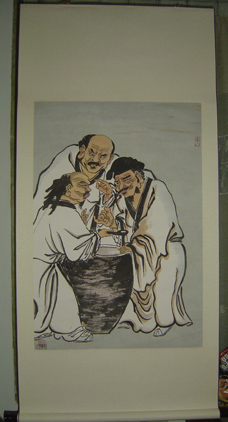
Three Vinegar Tasters - Serial #1Richard GarmanMechanicsburg, Pennsylvania #2: Michael Fowler, Philadelphia, Pennsylvania #3: Fons Martens, Limburg, Belgium #4: Luc van Renterghem, Moerbeke Waas, Belgium #5: Donald Bill, Warner Robins, Georgia #6: Laurene Snapp, Stuart, Florida #7: Alan C. Hogue, Texarkana, Texas #8: S. Sankaran, San Francisco, California #9: J. Pendleton, New Castle, Virginia #10: K. Roden, Madison, Alabama #11: J. Maher, Shrewbury, Massachusetts #12: A. Baldacci, Coos Bay, Oregon #13: P. Himmelreich, Nashville, Tennessee #14: A. Grisco, Oceanside, California #0: Ronald Faircloth, Salinas, California |
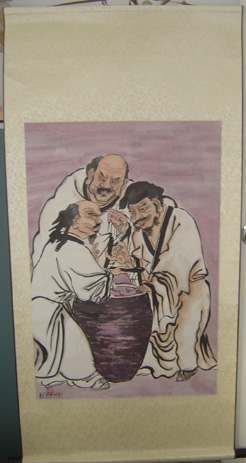
|

| ||
The following is a video describing the different Vinegar Tasters paintings...
HistoryThree SagesThe history of the Vinegar Tasters painting starts with the three sages: Confucius, Lao Zi, and Buddha, who each founded a philosophy or religion that affected China profoundly (Confucianism, Taoism, and Buddhism, respectively). Paintings depicting these "Three Sages" together later became very popular among artists.
Three LaughersAround 1000 years later, paintings with the subject "Three Laughers Over Tiger Ravine" became popular (similar theme to "Three Sages"). However, the three people in this "Three Laughers" painting are now Tao YuanMing (a poet: representing Confucianism), Lu XiuJing (a Taoist scholar: representing Taoism), and HuiYuan (a monk: representing Buddhism).
Three TastersAbout another 600 years later, paintings with the subject "Three Sages Tasting Wine" became popular (similar theme to "Three Laughers"). However, the three people in this "Three Tasters" painting are now Su DongPo (representing Confucianism), Huang ShanGu (representing Taoism), and FoYin LiaoYuan (representing Buddhism).
| ||
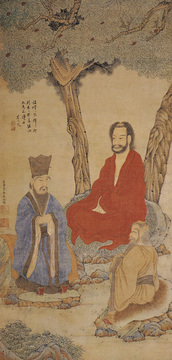 Three SagesArtist: Ding YunPeng (1547-1628)Item Location: Palace Museum, Beijing, China Style: Ming Dynasty of China |
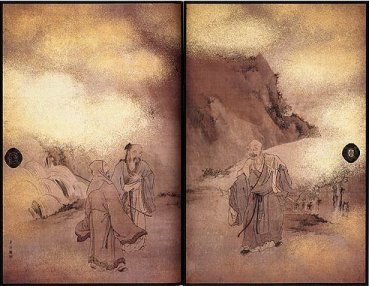 Three LaughersArtist: Kishi Renzan (1805-1859)Date: 1846 Item Location: Ryukokuji Temple, Hidaka-cho, Toyooka City, Japan Style: Kishi School of Kyoto, Japan |
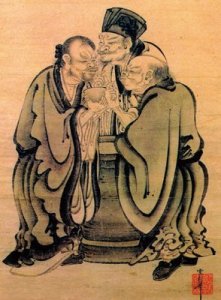 Three TastersArtist: Reisai (15th century)Item Location: Umezawa Memorial Hall, Tokyo, Japan |
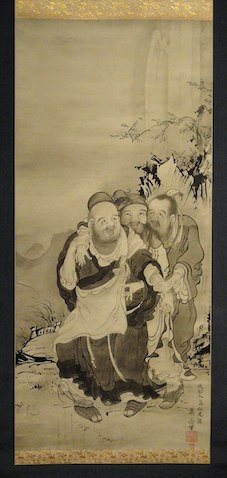 The Three Laughers of Tiger Ravine (虎渓三笑図)Artist: Soga Shohaku (1730-1781)Date: 18th Century Item Location: Indianapolis Museum of Art, Indianapolis, Indiana, USA Style: Muromachi era painter Soga Jasoku Description: The three laughers are Huiyuan (慧遠), Tao Qian (陶潜), and Lu Xiujing (陸修靜) | ||
Return to Taoism Depot Art Gallery

